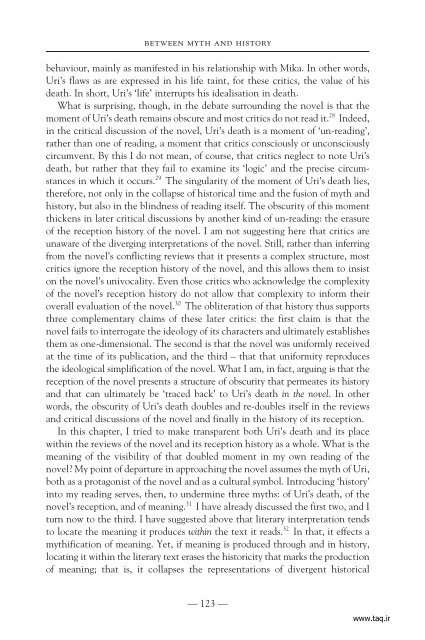LITERATURE AND NATION IN THE MIDDLE EAST
LITERATURE AND NATION IN THE MIDDLE EAST
LITERATURE AND NATION IN THE MIDDLE EAST
- No tags were found...
You also want an ePaper? Increase the reach of your titles
YUMPU automatically turns print PDFs into web optimized ePapers that Google loves.
etween myth and historybehaviour, mainly as manifested in his relationship with Mika. In other words,Uri’s flaws as are expressed in his life taint, for these critics, the value of hisdeath. In short, Uri’s ‘life’ interrupts his idealisation in death.What is surprising, though, in the debate surrounding the novel is that themoment of Uri’s death remains obscure and most critics do not read it. 28 Indeed,in the critical discussion of the novel, Uri’s death is a moment of ‘un-reading’,rather than one of reading, a moment that critics consciously or unconsciouslycircumvent. By this I do not mean, of course, that critics neglect to note Uri’sdeath, but rather that they fail to examine its ‘logic’ and the precise circumstancesin which it occurs. 29 The singularity of the moment of Uri’s death lies,therefore, not only in the collapse of historical time and the fusion of myth andhistory, but also in the blindness of reading itself. The obscurity of this momentthickens in later critical discussions by another kind of un-reading: the erasureof the reception history of the novel. I am not suggesting here that critics areunaware of the diverging interpretations of the novel. Still, rather than inferringfrom the novel’s conflicting reviews that it presents a complex structure, mostcritics ignore the reception history of the novel, and this allows them to insiston the novel’s univocality. Even those critics who acknowledge the complexityof the novel’s reception history do not allow that complexity to inform theiroverall evaluation of the novel. 30 The obliteration of that history thus supportsthree complementary claims of these later critics: the first claim is that thenovel fails to interrogate the ideology of its characters and ultimately establishesthem as one-dimensional. The second is that the novel was uniformly receivedat the time of its publication, and the third – that that uniformity reproducesthe ideological simplification of the novel. What I am, in fact, arguing is that thereception of the novel presents a structure of obscurity that permeates its historyand that can ultimately be ‘traced back’ to Uri’s death in the novel. In otherwords, the obscurity of Uri’s death doubles and re-doubles itself in the reviewsand critical discussions of the novel and finally in the history of its reception.In this chapter, I tried to make transparent both Uri’s death and its placewithin the reviews of the novel and its reception history as a whole. What is themeaning of the visibility of that doubled moment in my own reading of thenovel? My point of departure in approaching the novel assumes the myth of Uri,both as a protagonist of the novel and as a cultural symbol. Introducing ‘history’into my reading serves, then, to undermine three myths: of Uri’s death, of thenovel’s reception, and of meaning. 31 I have already discussed the first two, and Iturn now to the third. I have suggested above that literary interpretation tendsto locate the meaning it produces within the text it reads. 32 In that, it effects amythification of meaning. Yet, if meaning is produced through and in history,locating it within the literary text erases the historicity that marks the productionof meaning; that is, it collapses the representations of divergent historical— 123 —www.taq.ir






